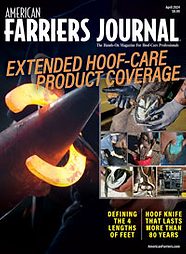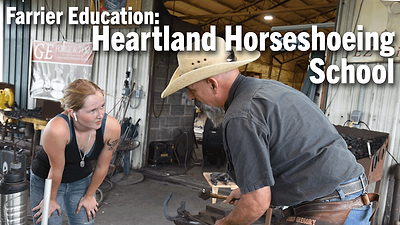“You spend all this time traveling, going to clinics, competing in contests and talking to other horseshoers. There cannot be that much to shoeing a horse, can there?”
The question stuck with me and made me think. Why do I spend all this time away from my wife and kids going to clinics, pursuing certifications, competing in contests, riding with other farriers and spending time in my shop practicing?
I thought back to the first few years of my career and how woefully ill-prepared I was when I got out of school. I thought I knew all there was to know about putting shoes on a horse. I was sure I was the best thing that ever happened to the trade. Those were the thoughts of a young man who was fresh out of school, just married and high on life. They were foolish thoughts, though. Quite frankly, they were uneducated thoughts as well.
Everything changed for me personally in August 2015. I had just joined an online group for farriers — a place to ask questions amongst peers without judgment. I had a question. A simple question that I should have had a quick answer to — or could have easily found myself by opening up my horseshoeing textbooks. However, the answers I received, being brutally honest as farriers are, opened my eyes to the holes in my education. So my journey into continuing education began.
So why is continuing your education after basic shoeing school important? I asked this question to a few fellow farriers and to some friends who work in other trades. There are a few commonalities that I found we all shared, and a few I had not considered.
Solidifying The Basics
When we go to shoeing school we start at the beginning. We start with some history and some basic anatomy. We learn to work in the forge and manipulate hot steel. Next, we probably learn how to use nippers and knives and rasps on a black length of pipe held between our knees to learn proper body position. All while our buddies walk up behind us and yank on it, knocking you off balance. Then we go out and trim. We might trim a foot or two a day for a week depending on the size of your class. After a week or so, your instructor might hand you a length of wood and a handful of nails and start driving nails. Then you learn to shape and nail on shoes, and finish feet.
Finally, we graduate and head home with just enough information to do a lot of harm. Some of us get lucky and find an apprenticeship. Some of us quit because it isn’t as easy as it was in school. And some of us will continue doing the same things we did in school — never asking for help, never improving.
So that brings me to my first point: Clinics solidify the basics. They help us see better or easier ways to trim a foot, shape a shoe, forge a clip or place a shoe so it doesn’t slip. The learning possibilities are only as limited as we make them.
I hear people mention all the time that their shoeing school was horrible and didn't teach them everything they needed to know. I don’t believe that to be the case, although I myself was guilty of thinking it at times. Schools teach us what we are ready to learn at the time. The instructor(s) can only fit so much into the short period of time that we are there. If we are lucky, we will remember 25% of what they teach by the end of the first year. The truth is we come out of shoeing school with the knowledge and experience to be a halfway decent helper. That is why it is on us to continue our education for as long as we choose to practice this trade. The responsibility is ours to learn, improve and pass on our knowledge.
New Technology And Products
New advancements are made in the world all the time. This holds true even in the ancient art of farriery. There’s always a chance that certain products will not advance as much as others. Some may even simply be a fad. But at times what may not work for one, may work for another. It’s about giving yourself as many skills and tools as you can. A lot of these products will sit on the shelf at the supply shops and we would never know about them or even think to try them if it weren’t for promotional clinics and demonstrations. As professionals in our trade, we should be aware of the new technologies and know the right ways to use and apply them.
Friendships And Burnout
Attending clinics and other continuing education events can be a great way to break out of the rut that we find ourselves falling into.
Our trade is a solitary and lonely one. Going to these events is a great way to meet new friends or reconnect with shoeing school friends. Maybe you are getting a little older and a little stiffer in the mornings, and because of that, you are looking for an apprentice or a helper to lighten the load. Or if you are new to the trade, you can build up contacts to call on for help and advice. It’s been my personal experience that those contacts can turn into great friendships.
Clinics also can be a great way to recover from that burned out feeling. We all have that feeling of not wanting to get up and go to work because it just isn’t fun anymore. Going to clinics can give you a whole list of things to work on or try in your business that give you that reason you have been looking for to get up and get back to it.
Professionalism
Even if they never say it, clients who know you are pursuing continuing education will respect and appreciate the professionalism that it portrays. It shows that you have a desire to learn and be better than you were the day before. You always leave with more knowledge than you had going in. It’s another tool in the toolbox, and it will always give you that competitive edge over those who don’t pursue it.
Knowledge and the experience to apply it are the two most important tools we can have, and we gain these skills through continuing education. You just need to be willing to be educated.







Post a comment
Report Abusive Comment